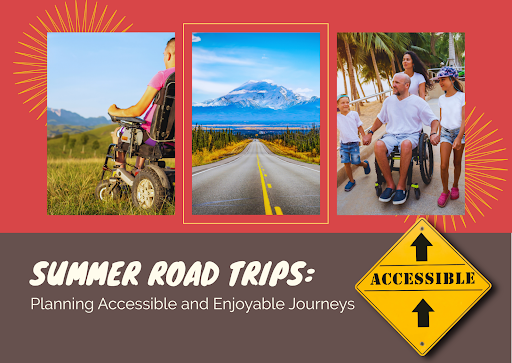
There’s something timeless about a summer road trip—the windows down, your favorite music playing, and the horizon wide open ahead. For many, road trips symbolize freedom, adventure, and spontaneity. And for individuals with disabilities, they can also represent something deeper: independence on your own terms.
With the right planning and tools, road trips can be not only possible but deeply enjoyable and empowering. Whether you’re a seasoned traveler or gearing up for your first accessible road trip, here are some ways to ensure your journey is both smooth and memorable.
1. Start with an Accessible Itinerary
The foundation of a great trip is thoughtful planning. When accessibility is part of the picture, it’s especially important to map out your route in a way that supports your needs and priorities.
Tips for accessible planning:
- Use resources like AccessibleGO or WheelchairTravel.org to research destinations and hotels.
- Look for ADA-compliant attractions, parks, and trails along your route.
- Prioritize drive times that feel realistic and leave room for rest, detours, or spontaneous stops.
- If you use a wheelchair or mobility aid, make sure the locations you visit have accessible parking and entrances.
Think of your itinerary not just as a schedule—but as a rhythm that allows for flexibility, energy breaks, and comfort.
2. Choose the Right Vehicle (and Equipment)
If you don’t already have an accessible vehicle, consider renting an adaptive vehicle for your road trip. Many companies now offer vans, SUVs, and cars equipped with:
- Hand controls or left-foot accelerators
- Transfer seats
- Wheelchair lifts or ramps
- Ample storage space for medical or mobility equipment
Where to start:
- Companies like MobilityWorks, Wheelchair Getaways, or local mobility dealers often rent adaptive vehicles.
- Make your reservation early—especially during summer months when demand increases.
- Ensure the vehicle fits your specific needs (and luggage space!).
3. Pack Smart: Comfort is Key
Packing for a road trip is always an art, but when accessibility is a factor, it’s even more important to consider comfort and convenience.
Don’t forget:
- Seat cushions, lumbar support, or neck pillows for long rides
- Easy-to-reach essentials like medication, snacks, water, and emergency info
- Charging cables for any powered mobility or medical devices
- Cooling products like a handheld fan or cooling towel if you’re heat-sensitive
- A small toolkit or repair kit for mobility devices, just in case
Bonus tip: Pack a “first day” bag with everything you might need in the first 24 hours, separate from the rest of your luggage.
4. Know Your Rest Stop Options
Not all rest areas are created equal, but many states have been making strides toward ADA-compliant facilities.
What to look for:
- Accessible restrooms with wide stalls, grab bars, and automatic doors
- Level entryways and ramps
- Pet relief areas if you’re traveling with a service animal
Use apps like iExit or Roadtrippers to scout out rest stops and amenities before you hit the road.
5. Make Space for Joy and Spontaneity
Road trips are about more than logistics—they’re about connection, discovery, and freedom. Accessibility may require more planning, but that doesn’t mean you have to sacrifice the magic of the journey.
Stop for roadside attractions. Take the scenic route. Watch the sunset from a new place. And don’t forget to celebrate what you’re accomplishing—mile by mile.
Final Thoughts: The Road Is Wide Open
An accessible road trip isn’t just about where you go—it’s about how you feel along the way. Safe. Comfortable. Independent. Free. And while the world still has a long way to go in making travel fully inclusive, more tools and resources are available now than ever before.
So this summer, don’t let barriers hold you back. With the right vehicle, a little planning, and a sense of adventure, the road is wide open.
📩 Need help navigating your driving journey?
At Driving to Independence, we specialize in helping individuals explore their mobility options—from adaptive driving evaluations to personalized training and equipment recommendations.
Contact us today to take the next step toward freedom behind the wheel.
